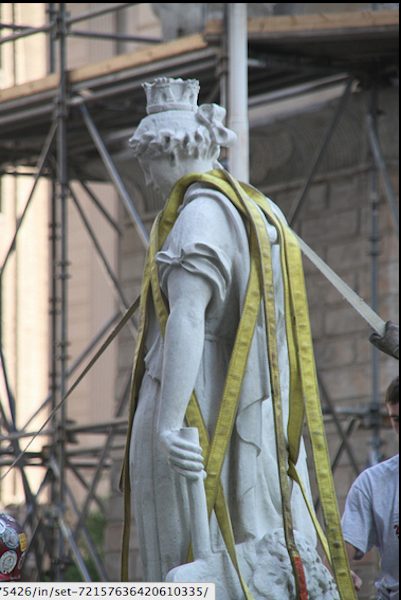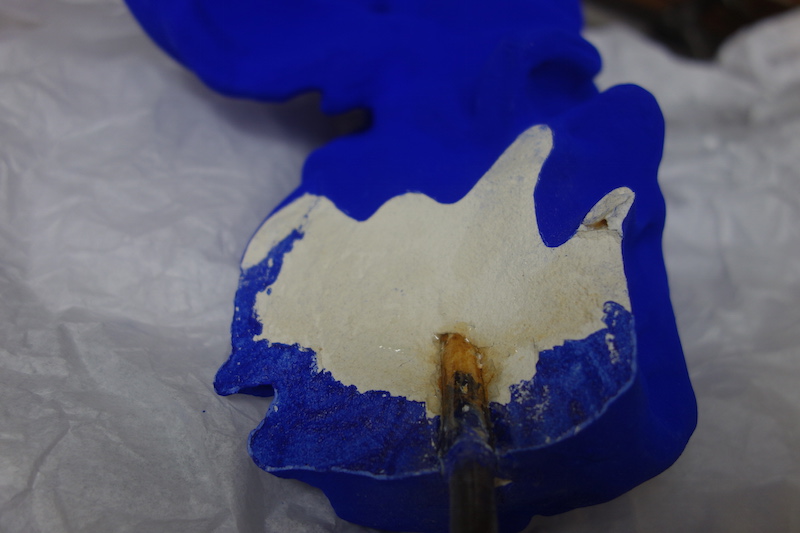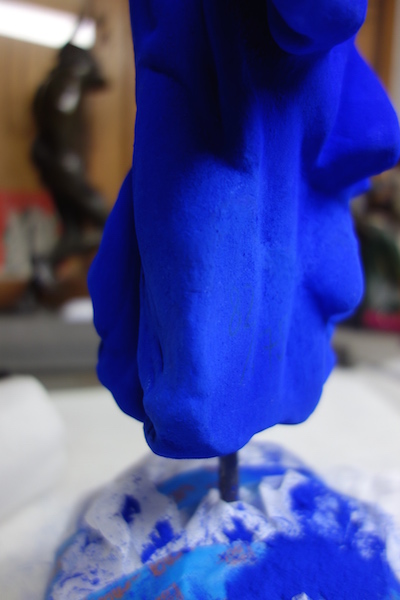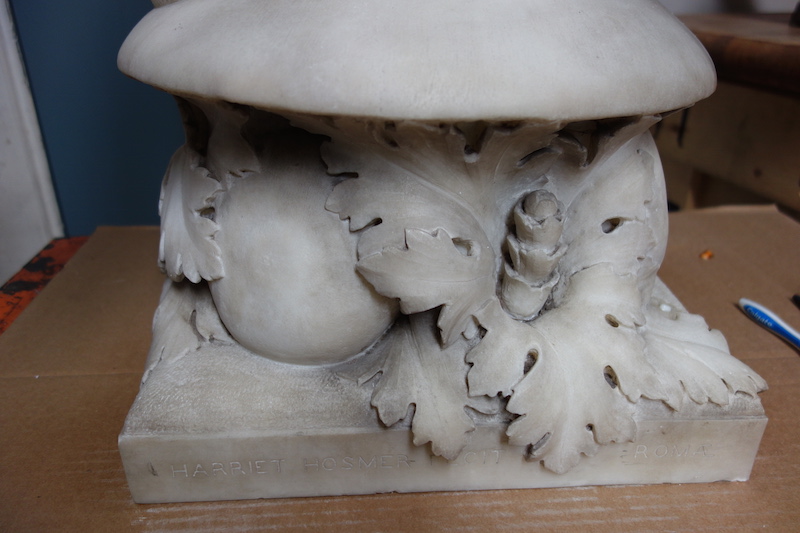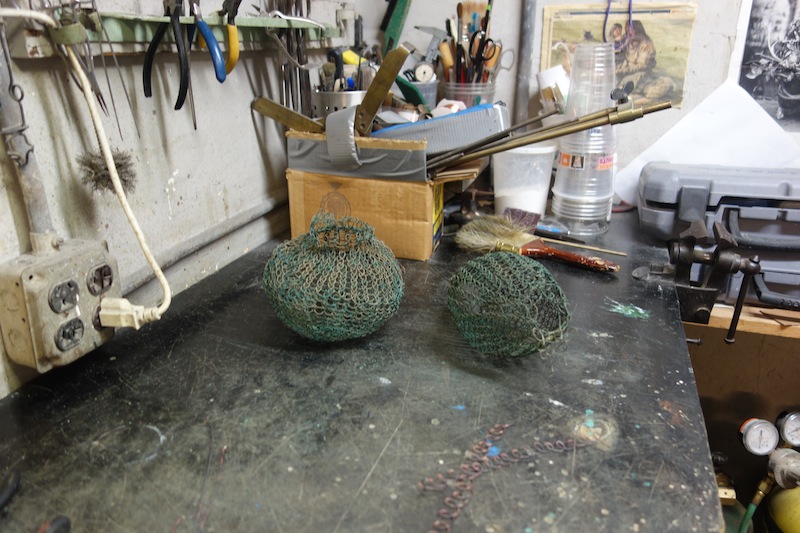This serene lady got so lost in her ruminations during her many years in the shop, that her head separated from her body! Much of the original material was missing so it needed to be replaced with other wood, filled with hard-curing putty, and touched up with some paint. Quite the reconstructive surgery!
Read MoreMarch 2018: Girl of the Month
This adventurous little girl by Abastenia Eberle took quite a tumble down a hill seconds after yelling “Look Ma—ONE SKATE!!” She arrived in our sculpture emergency room with 2 cracks in her skate, a cracked ankle, and 3 bent fingers. With the cracks brazed and sealed and her fingers heated and moved back into place, she is fully recovered and ready to roll. Hopefully now the young thrill seeker will exercise a little more caution in the future!
Read MoreFebruary 2018: Girl of the Month
Most of the time, Lachaise depicted his big sassy women in the nude. But this time, she’s dressed and ready for her big night out (even her petite feet are donning elegant pumps. She was given our special spa treatment: gently exfoliated, waxed, and massaged to a shine. Now she’s more confident than ever-you go Girl!
Read MoreJanuary 2018: Girl of the Month
Starting in January 2018, Tatti Art Conservation is going start posting a monthly image and excerpt on a sculpture of a female figure that comes through the shop. Maybe we'll get a calendar together by the end of the year!
Read MoreAlbert Cheuret- Alabaster Shades
How does one recreate an alabaster shades? I'm about to show you how. This post will walk you through the multiple steps involved in recreating the iconic alabaster shades found in the chandeliers and light fixtures designed by Albert Cheuret.
Original Shades
Step 1. Understanding what you have
For various reason, this project only called the recreation of new shadesthat were totally broken and unusable. In this instance multiple piece has broken and been repair in the past (as you can see) but only a total of 4 shades needed to be recut.
Step 2. Creating a template and layout
After examining all the shades and deciding which piece needed to be cut, we created templates for each shade to guide us in choosing the right sized alabaster for the job. Once we got the alabaster, it was time to trace out our pieces.
Step 3. Get cutting
If you've ever cut stone before you know, it isn't always the easiest task. In order to get straight rough cuts to get the pieces to a more manageable size, you need special diamond covered saw blades and an abundance of water (to keep the stone from overheating).
Step 4. The toughest cut of all
Unfortunately in today's stone market, even at the best suppliers, coming across a stone precut to the width you need is hard to come by. Most stone, especially exotic marbles, are cut exclusively cut in 1-2 inch slabs for kitchen counter tops. In this case, the alabaster was no different. In order to get the 3/4 inch width that we needed, we have to resaw these pieces vertically. Boy was this a challenge.
Step 5. Shaping up
Even though our hands with power tools are pretty darn steady, to obtain the totally straight and flat sizes we need for this project, the carving and shaping at this stage needs to be done using using a flat jig.
Step 6. The Bevel
Once the pieces were the exact shape and width we needed, it was time to hand carve a bevel to each piece. Using small rifflers, each piece was shaped to match the contour of the piece it sat next to in order to create a uniform flow.
Step 7. The fit and finish
After the pieces were completely carved, the shades were ready to be matched and fit to their within the chandelier. As much as we loved our brand new beautifully craved shades, we knew they would look out of place adjacent the original shades that were over 50 years old. In order to artificially age the alabaster to match the originals, we put the new pieces through series of wax, dirt, and heat treatments similar to that of the original pieces. Can you tell me which ones we made?
Creative Techniques
Watch Nick and Steve Tatti use their knowledge of solubility to apply the gilt lettering to a marble plaque during the restoration efforts at St. Paul's Chapel for Trinity Church Wall Street. Here we used molasses as a water soluble resist on the high areas, and then applied a high quality oil based paint to the recesses. After the paint dried, we were able to wash away the molasses with water with any overspray, leaving the recesses filled with clean gold filling.
Before Molasses Treatment
After Molasses Treatment
Tatti Art Conservation embarked on a journey to repair an iconic work by one of the worlds most celebrated sculptors; Henry Moore
In the spring of 2015, we received a distress phone call from a client regarding a large outdoor sculpture by Henry Moore. The figure was crushing its seat putting the entire sculpture at risk
Treating outdoor sculpture to survive the elements is a conservation topic we routinely address at Tatti Art Conservation. This Seated Figure by Henry Moore presented a unique structural problem not usually associated with cast bronzes. With this piece and other early works by Moore he constructed the base out of wood then clad them in copper sheeting. Over time the wood rooted and the figure began to collapse and crush the bench. In order to correct this, the piece needed to be completely de-installed and the cladding and wood removed.
The entire copper sheeting was carefully removed and the rotted wood taken away. A new aluminum sub structure was fabricated to exact measurements, the copper cladding straightened and repaired as needed. The repaired copper was attached to the base and the entire piece assembled with the figure. This was a unique and challenging repair job to maintain the original materials, finish while improving the structural integrity of the work.
The Art and Furniture of Surrealist Sculptors Francoiss-Xavier and Claude Lalanne
Recent conservation projects have featured the work of both François-Xavier Lalanne and his wife and artistic partner, Claude Lalanne. Lalanne turned interior design on its ear when, in 1964, he created a rhinocerous-shaped secretary. A zoo full of creatures followed including his most famous creations, “Moutons,” 24 sheep figures meant to serve as stools or seats. Lalanne counted Max Ernst, Man Ray, Marcel Duchamp, and Constantin Brancusi (with whom he shared studio space) as artistic influences. Francois Lalanne died on December 7th, 2008 at his home in the village of Ury, south of Paris.
Projects at the Tatti Studio have included:
- “Moutons”
- Bronze Crocodile Chair
- “Chat Polymorphe”, a sculpture with a bar hidden inside
- Pomme de New York
- Ginko Chair
Donald De Lue’s 1964 Rocket Thrower
The Municipal Art Society of New York has contracted Tatti Art Conservation to restore The Rocket Thrower by Donald De Lue, which was commissioned for the 1964/65 World’s Fair in Flushing Meadows, Queens, NY. The Rocket Thrower Monument is slated for a full conservation by Steve Tatti’s and Tatti Art Conservation as part of the Municipal Arts Society’s Adopt-a-Monument program. The conservation work will include a restoration of the verdigris bronze patina, as well as an application of gold leaf to the constellation of stars and rocket.
The treatment will require our crew to work under the punishing summer sun, standing on two lifts that each reach the 43’ height of the monument. First we will need to detail clean the statue to reveal the underlying verdigris patina. Once the base patina is exposed we will begin to tone and harmonize the streaked and distorted surface using a combination of mechanical and limited chemical repatination. Once the patina is blended, the team will skillfully maneuver the lifts to reapply gold leaf to the constellation of stars and rocket surrounding the figure. The process is laborious and time consuming, but the end result will speak for itself.
Anna Hyatt Huntington’s Passing the Torch
Anna Hyatt Huntington’s bronze monument, Passing the Torch, cast in 1962, is on the move to its new home in Houston, Texas. Huntington is one of the most revered female sculptors in the United States, capturing the essence of both savage and domestic animals within her artworks.
Passing the Torch was recently sold by the Discovery Science Museum, located in Bridgeport, CT, through the well-known Bonham’s Auction House. Before the sculpture is permanently relocated, the Tatti Art Conservation team will undertake a series of complex techniques to assure its readiness for the outdoor environment. Our hopes are to complete the entirety of our work, including the installation, by the fall of 2014.
Cleopatra’s Needle- An Ancient Egyptian Obelisk
Located directly behind the Metropolitan Museum of Art in Central Park is an ancient Egyptian Obelisk, known as Cleopatra’s Needle. In the 15th century BCE, nearly 3500 years ago, Cleopatra’s Needle was carved out of a single piece of pink granite. The obelisk was commissioned by Thutmose III who planned for its placement outside a temple in the ancient Egyptian city of Heliopolis.
For nearly 1000 years Cleopatra’s Needle remained standing in Heliopolis until an invasion by the Persian Empire (in 525 BCE) had it toppled and possibly set ablaze. This powerful testament of Thutmose III’s reign was seemingly forgotten for another 500 years when Emperor Caesar Augustus discovered it half buried in sand. Augustus had the obelisk transported to the City of Alexandria, where it stood until the 19th century. In 1880 Cleopatra’s Needle began its long journey to its current location in Central Park.
Our conservation team has been working diligently to preserve the hieroglyphs that give us insight into a 3500-year-old civilization. We will be working on-sight through October, we encourage everyone to come by and see our work!
Lady Baltimore Restored: Commemorating the War of 1812
As the oldest stone monument in the country, The Battle Monument, located in Baltimore, Maryland, stood tall in the city’s Courthouse Square for nearly 200 years. Perched on top of the monument, Lady Baltimore proudly gazes upon the Baltimore Harbor where some 1000 American soldiers fought against an onslaught from nearly 20 British Naval ships. After just 27 hours, American soldiers successfully thwarted British efforts to take Baltimore’s harbor.
Over the past three years, the Tatti Art Conservation team worked with The City of Baltimore to bring The Battle Monument back to life. This included a range of treatments from cleaning, restoring, consolidating, and even reproducing Lady Baltimore!
In 2014, a replica of Lady Baltimore was painstakingly created and installed at the site and the original was brought to a new, more stable home at Maryland’s Historical Society.
Rockefeller Center – Medallion Series
The restoration of the three medallions that grace the south façade of Radio City Music Hall was a major undertaking, involving considerable scholarship and metallurgical expertise. These ornate metal-and-enamel plaques – each measuring an impressive 18 feet in diameter – were created in 1932 by the American mosaicist and painter Hildreth Meiere in collaboration with the master metal worker Oscar B. Bach. It was a felicitous pairing of artistic talents. Meiere, one the few women of the time working in the field of architectural decoration, was at the high point of her career. Bach, the redoubtable technician, was one of the few people able to realize her elaborate – even audacious – designs. Interestingly enough, Meiere’s medallions, which celebrate Dance, Drama, and Song, were among the first artistic works completed for the center and they have served as enduring emblems of Radio City Music Hall.
“What’s unique about these medallions,” notes Steven A. Tatti, who served as conservator on the project, “is that Meiere and Bach used the natural finishes of metals – which include copper, aluminum, brass, steel, and an aluminum alloy called duraluminum – to achieve their desired coloring effects.” In execution, the medallions are wonderful examples of “high Art Deco,” he says. The classically inspired figures, symbolizing the performing arts, are “highly stylized and theatrical, and their movement and energy manage to capture the whole feeling of Radio City and of the art of the 1930’s.” The Meiere-Bach triptych, he adds, “is one of the truly great exterior sculptures of New York City.”
The medallions required attention because they had begun to show the effects of more than six decades of exposure to the elements of New York City. In places, the artist’s brilliantly colored enamels were fading. Portions of the steel armatures that secured the plaques to the Music Hall’s limestone façade had deteriorated. So had areas of the steel frames that held sections of the design elements together.
The project, managed by Rockefeller Center’s Architecture, Planning, and Construction Dept. under the direction of vice president Alan Hantman, began in June 1993 and took four months to complete. Hantman hired Tatti, a noted art conservator who has worked for the Smithsonian Institution and Corcoran Gallery of Art in Washington, DC, to supervise the restoration, and he selected Tallix, Inc. of Beacon, New York, to handle the highly specialized metal casting and fabrication work. Tallix, one of the world’s largest and most respected foundries, fabricates metal sculptures for such noted artists as Frank Stella and Roy Lichenstein.
The first challenge was to dismantle the medallions safely. All three plaques were constructed in steel sections attached to steel support armatures. The armatures, in turn, were anchored to the building façade with brass sleeves set in lead. These sleeves had to be removed carefully so as not to damage the sculptures or the building façade. A hydraulic crane with a safety cage was used to remove the elements, which were then wrapped individually and transported to Tallix for restoration.
At Tallix, the hundreds of individual pieces of tarnished, and in some cases oxidized, metal had to be stripped, cleaned, refinished, and reassembled in new corrosion-resistant steel armatures and frames. A reinforced fiberglass polyester resin was used to repair any holes or cracks in the design elements, and a silicone gasket material was applied to those areas where it was felt there might be potential for future ionic transfer and galvanic corrosion of metals.
As a final step prior to the medallion’s reinstallation, the Music Hall’s limestone façade was re-pointed and washed.
Because Rockefeller Center has been designated a national historic landmark as well as a New York City landmark, the National Park Service; the New York State Office of Parks, Recreation and Historic Preservation; and the New York City Landmarks Preservation Commission all took an active interest in the project, from its inception to its happy finale in October, when Hildreth Meiere’s medallions were replaced in their familiar spots 60 feet above street level, overlooking 50th Street.
“Nobody has ever done any restoration work on a mixed-metal sculpture of this scale before,” says Hantman. “We’re very pleased with the high level of professionalism and cooperation exhibited on this project by the whole conservatorial team.”
The Art of Restoration, of Illumination, by C. Torello, D. DeCrette & M. Friedman, The Center Magazine of Rockefeller Center, Jan./Feb. 1994.
Baltimore Battle Monument
During Spring and Summer 2011, Steve Tatti’s team of conservators undertook the restoration of the historic 1814 Baltimore Battle Monument. Erected to commemorate the Baltimore citizens lost during the war of 1812, the completion of the monument predates the Washington Monument and is the oldest battle monument in the US. The monument is depicted on the seal of the City of Baltimore that was adopted in 1827.
The conservation scope includes: cleaning of both the local Cockeysville marble and the imported Italian Carrera marble; repointing of all joints at the base Egyptian Revival structure; and mold taking and casting of existing sculptural elements for possible future replacement, including four griffins and Lady Baltimore herself.
International Klein Blue
Yves Klein (1928-1962) was one of the most influential and controversial French artists during the 1950’s and is renowned for his intense study of color. His art is instantly recognizable due to his concentrated efforts to explore the tonal varieties of a singular color in particular, his patented International Klein Blue, or IKB.
Klein’s work, which almost exclusively uses his patented pigment, transfers the focus from the sculptural form to the intense color found within the vibrant blue. No better example of this can be found is his depictions of the iconic figures of Venus or Nike.
While the aesthetic is undoubtedly captivating in Klein’s pieces, they present a particular challenge from a conservation standpoint. Structural repairs to plaster are run of the mill and can done easily and successfully, but recreating the exact pigment and surface texture is near impossible. By testing specific dilutions of polyvinyl acetates in conjunction with pigments similar to IKB, we are able to recreate a surface coverage that presents to a near match. These treatments become even more difficult in localized areas.
A Recently Restored Marble
Harriet Hosmer was an extraordinary artist known as the foremost American female sculptor of the 19th century. Encouraged by friends and family, Hosmer traveled to Rome to pursue her natural talents in the art of sculpture. She quickly established prominence and received her first commissioned work in 1856.
Our conservation team worked tirelessly to clean and restore Puck, a magnificently carved marble sculpture.
Repairing A Ruth Asawa
Our conservation team restored a section of an eight foot wire sculpture by Ruth Asawa. She created a number of these crochet wire sculptures ranging in both size and complexity. Asawa’s goal with these wire sculptures was to create new and original works of art while using commonplace materials. These materials were mainly iron, copper, brass and on certain occasion other materials that met her specific needs.
Speed By Harriet Frishmuth
Completed Restoration
Harriet Whitney Frishmuth was an American born artist who studied closely with man renowned sculptors including Augustus Rodin and Gutzon Borglum. After her studies in Paris and Dresden, Frishmuth returned to the US and soon became recognized as one of the groundbreaking female sculptors of her time. She was best known for her ability to uniquely portray movement in her works of both human and animal figures. Although her favorite models were that of female dancers, her skill set allowed her to explore many other styles, forms, and medium.
Speed, created in 1921, is an exceptional example of Frishmuth’s ability to explore these alternative artistic styles. This Art Deco-style hood ornament was created during her short stint working at Gorham Manufacturing Company. Our conservation team worked to repair surface imperfections, bent/cracked features, as well as a compete re-plating of the sculpture. We are honored to have worked on one of the 30 created by Harriet Frishmuth during the 1920’s.
It’s March Madness in the shop and Harry Bertoia rules
As an Italian born American artist, Harry Bertoia has been a popular artist throughout his life. He created art in a wide range of styles but is mostly recognized for his sonambient sculptures and furniture designs. We are currently enjoying the influx of Bertoia’s here at the shop due to sales at both Wright and Sotheby’s.
Emergency Surgery!
Franz Von Stuck’s Amazon came in last Friday for an emergency repair. A damaged spear had to be reattached in time for a Saturday morning sale at Christies. The Bavarian born artist was a renowned painter/sculptor during the late 19th and early 20th centuries.















































